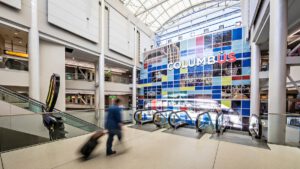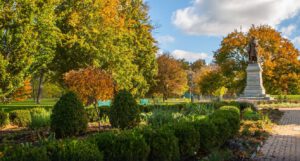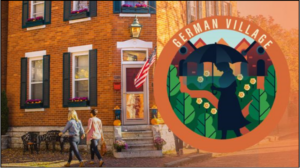
June 12-15, 2025
CLICK HERE to download the Whova app & access the web portal
Conference links
| Register online | Register by mail | Speaker profiles | Weekend schedule | Hotel reservations |
| Presenter videos | Be a sponsor | Be a vendor |
Logistics | Sponsors & vendors |
NEWS (MARCH 4): Presenter videos posted
We’ve begun to post videos from our speakers inviting you to the conference and previewing their presentations. Visit the IGGP YouTube channel and play through the 2025 playlist.
NEWS (10 FEB. 2025) TOUR SOLD OUT Arrive early and join German Village tour on Thursday
Genealogists attending the 2025 International German Genealogy Conference are being offered an extra treat: a bus tour to German Village and the Palatines to America Collection at the Columbus Metropolitan Library.
Starting at 9 a.m. on Thursday, June 12, our bus will transport us to the southern section of Columbus settled by German immigrants in the 19th century. Known for charming brick houses, brick streets and brick sidewalks, German Village has retained its architecture with little change over the past 175 years. Our morning tour includes stops at Trinity Lutheran Church and St Mary of the Assumption Church both established in the mid-19th century by German Immigrants.
Then we will have a traditional German buffet at Schmidt’s Sausage Haus — bratwurst, chicken, sauerkraut, German potato salad, chunky applesauce, green beans, tossed salad and Schmidt’s famous mini cream puffs for dessert — all included in the tour registration fee.
Following lunch will be an hour-lomg guided tour of German Village highlights, including a stop at Schiller Park named in honor Friedrich Schiller, 18th century German playwright and poet.
Our last stop is the Columbus Metropolitan Library where we will have an hour to explore the German resources in the Palatines to America Collection. Be sure to consult the online catalog prior to the tour.
We will return to Nationwide Conference Center in time for the Welcome Reception at the Vendor Exhibits.
UDPATE (31 JAN 2025) Additional hotel rooms now available
Hotel rooms at the conference venue have been sold out. You can book using a comparable conference room rate at the nearby Hyatt Place Hotel. Or make your own arrangements at the hotel of your choice. See the hotel reservation page for details.
NEWS (25 Nov. 2024) First Connection sessions confirmed
Continuing a popular attendee tradition since the initial conference in Minneapolis in 2017, there will be Connection sessions at the conference next year. These give attendees an opportunity to participate in group discussions and Q&A periods devoted to research resources in specific geographic regions related to their own research. The first set of Connection sessions and the discussion moderators have been announced:
- Austria Connection Session, Christina Kaul
- Bavaria Connection Session, Teresa McMillin
- Bohemia, Moravia, Austrian-Silesia Connection Session, Christina Kaul
- East Prussia and West Prussia Connection Session, Ute Brandenburg
- Baden-Württemberg Connection Session, Debra A. Hoffman
NEWS (10 Nov. 2024) Speaker lineup is announced
The Presenter Committee for the 2025 IGGP Conference is pleased to announce the complete list of presenters for the 2025 IGGP Conference. We consider this to be a stellar lineup of presenters with an immense knowledge of diverse areas of German genealogy. Additionally, we are quite pleased to have ten of the presenters from outside the United States (Germany, Austria, Belgium, and Israel) to provide an opportunity for Americans to hear from an international group of presenters.
The presenters for the 2025 IGGP conference and the presentations they will be giving are:
- Edie Adam, Everything Old is New Again
- Dr. Sabine Akabayov, Citizenship and Nationality Laws in German Lands, and It’s All Hebrew to Me: Reading Jewish Gravemarkers
- James M. Beidler, The Peculiarity of Pennsylvania Germans and Matching Villages with Church Records: A Methodical Approach
- Andrea Bentschneider, From Citizenship to Serfdom: Understanding German Social Classes Before 1871 and Tying the Knot and Cutting the Cord: Weddings, Marriage Contracts & Divorces in 19th Century Germany
- Warren Bittner, Was ist Das? Little-used German Resources of the FamilySearch Library and Village Family Books (Ortsfamilienbücher): What They Are, How to Use Them, and How to Find Them
- Gail S. Blankenau, MA, Artficial Intelligence in Action: Unveiling the Potential and Pitfalls for German Genealogy and Find Family in Numbers: How to Find and Navigate German Census Records
- Ute Brandenburg, Finding Volker’s Father
- Charlotte Noelle Champenois AG®, AGL™, Locating and Decoding Swiss Censuses from the 1600s-1900s and Locating German Immigrants in the United States
- Roland Geiger, A Walk in the Woods and Civil and Church Records — Their Differences & Similarities
- Dr. Wolfgang Grams, Small Emigration Museums and Sites in Germany
- Kenneth W. Heger, Ph.D., Getting Started at the National Archives at Home
- Debra A. Hoffman, PLCGS, Early U.S. German Religious History — Learn About the Methodology and Sources and Early German Settlements on the East Coast–Their Impact and Records
- Baerbel K. Johnson, AG®, Digital Libraries — A Goldmine for German Genealogists
- Daniel R. Jones, MS, AG®, Leaving Their Mark: Finding Post-Emigration Records in the Homeland and Emigration Strategies: Revealing Chain Migration
- Christina Kaul, Emigration from the Austrian-Hungarian Empire to the U.S.: An Overview in Time and Regions
- Timo A. Kracke, Hidden Gems About Your Families in German Archives and Beyond Genealogy.net — Discover the Online Records of German Genealogy Societies
- Ursula C. Krause, Family Law According to the Prussian Civil Code 1794-1899 and Ten Things to Know Before Starting Research in Germany!
- Michael D. Lacopo, DVM, Telling Their Story: Adding Character to Your Genealogical Narrative and The German-American Immigrant Experience in the 18th Century and The Early Religious Experience of Germans in Colonial America: The Theology Behind the Records
- Teresa Steinkamp McMillin, CG®, Nineteenth-century German Migration to Midwest United States and German Village History: Your Key to Researching Beyond Church Records
- Roger P. Minert, What Else Can I find in American Church Records and Making Sense of the German Empire: Properly designating & Recording Place Names
- Greg D. Nelson, Denazification Proceedings Digitization And Keying ― A Wiesbaden/FamilySearch Project
- Günter Ofner and Angelika Schmalbach, Understanding the Differences between the Habsburg and German Empires
- Barbara Schmidt, Thyssen, Daimler, Bosch & Co. — It’s in the Corporate Archives
- Katherine Schober, AI and the Old German Handwriting: Will it Work? and Cracking the Code: Fun with German Handwriting
NEWS (9 Sept. 2024): Join us as a sponsor or vendor
Information for those who are interested in becoming a sponsor or exhibitor or both for the 2025 conference is now available. See the “Be a sponsor” and “Be a vendor” pages.
Travel and logistics
 The center is a short drive from John Glenn Columbus International Airport (CMH). It offers more than 50 direct flights from U.S. cities as well as connections to major international gateway airports including Washington, D.C., New York, Chicago, San Francisco and Los Angeles.
The center is a short drive from John Glenn Columbus International Airport (CMH). It offers more than 50 direct flights from U.S. cities as well as connections to major international gateway airports including Washington, D.C., New York, Chicago, San Francisco and Los Angeles.
Das Zentrum ist nur eine kurze Fahrt vom John Glenn Columbus International Airport (CMH) entfernt. Er bietet mehr als 50 Direktflüge von US-Städten sowie Verbindungen zu wichtigen internationalen Flughäfen wie Washington, D.C., New York, Chicago, San Francisco und Los Angeles.
Photo credit: Columbus Regional Airport Authority
Columbus and its German heritage
 |
 |
Downtown Columbus with its historic German Village neighborhood and restaurants is a short distance. (Video: German Village) Stop in at The North Market, Columbus’ historic public market since 1876. And there is plenty of German history all around to enjoy before or after the conference.
Das Stadtzentrum von Columbus mit seinem historischen Viertel German Village und seinen Restaurants ist nur einen Katzensprung entfernt. (Video: German Village) Besuchen Sie den North Market, Columbus’ historischen öffentlichen Markt seit 1876. Und vor oder nach der Konferenz können Sie noch viel deutsche Geschichte erleben.
German roots in Columbus
German Village is a historic neighborhood south of downtown that was settled largely by German immigrants in the mid 1800s.
Many German immigrants served in the American Civil War, earning the respect of fellow residents. By 1865, the community was flourishing with businesses, schools and churches. The schools were so good that English-speaking residents of Columbus chose to attend. Sturdy brick homes with wrought iron fences along tree-lined streets were built. The former City Park was renamed Schiller Park in 1891.
But World War I sparked anti-German sentiment, and Prohibition in the 1930s led to the closing of local breweries. The neighborhood was declining, and people were leaving for the suburbs.
Facing the threat of neighborhood demolition, the German Village Society was created in 1960 to promote its preservation and rehabilitation. Today, German Village is a success story of urban renewal and has been listed on the National Register of Historic Places since 1974. Its brick homes are desirable, and the neighborhood features shops and restaurants as well as the fountains and flower beds of Schiller Park.
Deutsche Wurzeln in Columbus
German Village ist ein historisches Viertel südlich des Stadtzentrums, das Mitte des 19. Jahrhunderts hauptsächlich von deutschen Einwanderern besiedelt wurde.
Viele deutsche Einwanderer dienten im amerikanischen Bürgerkrieg und erwarben sich früh den Respekt ihrer Mitbürger. Um 1865 florierte die Gemeinde mit Geschäften, Schulen und Kirchen. Die Schulen waren so gut, dass sich auch englischsprachige Einwohner von Columbus dafür entschieden, sie zu besuchen. Es wurden robuste Backsteinhäuser mit schmiedeeisernen Zäunen entlang der von Bäumen gesäumten Straßen gebaut. Der ehemalige Stadtpark wurde 1891 in Schiller Park umbenannt.
Doch der Erste Weltkrieg löste eine antideutsche Stimmung aus, und die Prohibition in den 1930er Jahren führte zur Schließung der örtlichen Brauereien. Das Viertel verfiel, und die Menschen zogen in die Vororte.
Angesichts des drohenden Abrisses des Viertels wurde 1960 die German Village Society gegründet, um die Erhaltung und Sanierung des Viertels zu fördern. Heute ist German Village eine Erfolgsgeschichte der Stadterneuerung und steht seit 1974 auf der Liste des National Register of Historic Places. Die Backsteinhäuser sind begehrt, und das Viertel verfügt über Geschäfte und Restaurants sowie die Springbrunnen und Blumenbeete des Schillerparks.
Schedule and special events
Pre-conference activities, including a partnership representative meeting, German Village tour, and a welcome reception, will be held on Thursday, June 12, 2025.
Friday evening June 13, Palatines to America will host its 50th anniversary dinner.
Saturday evening June 14 will feature the IGGP partner gala.
The last presentations are Sunday afternoon June 15.
Conference registration
Conference registration will open on Dec. 1, with “early bird” pricing available until Feb. 28, 2025. Regular registration will be $349, discounted to $299 during the early bird period. In addition to 40 sessions from national and international experts, the registration fee includes the welcome reception and lunch on both Friday and Saturday. Separate fees will apply to the German Village tour, Friday evening PalAm anniversary German dinner, and Saturday evening IGGP anniversary celebration.
You can subscribe to the IGGP email list to receive an announcement. Or keep a lookout on this website for details.
Things to see and do in central Ohio
Coming soon!
